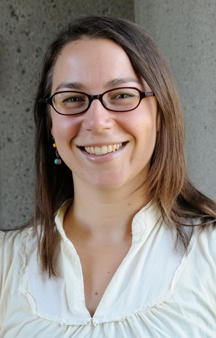
The excitement began when Martin Guerena, an integrated pest management (IPM) specialist with the City of Davis, encountered a native bee nesting site Wednesday in front of the U.S. Bank, corner of 3rd and F streets, Davis.
Some passersby figured they were wasps and were asking bank officials to exterminate them.
Guerena contacted UC Davis officials and learned that these particular bees were sunflower bees, Svastra obliqua expurgata, nesting underground. Native pollinator specialist Robbin Thorp, distinguished emeritus professor of entomology at UC Davis, identified them, and Katharina Ullmann, who last year received her doctorate in entomology from UC Davis and is now a crop pollination specialist with the Xerces Society for Invertebrate Conservation, circled the site with yellow caution tape today and posted an educational sign.
"This is a sunflower bee nesting site," Ullmann wrote. "These gentle bees are native and ground nesting. The females of this species are solitary bees, but like to nest near each other and often use the same nest entrance. Their nesting tunnels lead to individual chambers below the ground. Each chamber is filled with pollen, a single egg, and then closed off. These eggs will hatch, develop underground, and emerge next summer to build their nests. This sunflower bee is one of 1600 species of native bees found in California."
The sign included a "name tag" with the common name, scientific name, favorite food (pollen and nectar), favorite place to be (3rd St., Davis), favorite colors (yellow, red and orange) and favorite saying (YOLO, You Only Live Once).
Ullmann added: "Three things you can do to help this bee: (1) protect nests, (2) plant flowers and (3) use fewer insecticides.
Sunflower bees are also nesting nearby--near the Pizza Guys restaurant and the 7-Eleven parking lot. UC Davis entomology graduate student Margaret "Rei"Scampavia identified the bees as from the same genus, and also noted the presence of cuckoo bees.
Thorp says the female cuckoo bee, Triepeolus concavus, lays her eggs in the ground nests of other bees, including the sunflower bee, Svastra. Cuckoo bees are kleptoparasites, meaning that they steal the food stores provisioned by the host bee. Cuckoos lack pollen-collecting structures (scopa). So when the cuckoo bee eggs hatch, the larva will consume the pollen ball collected by the hosts, and kill and eat the host larvae. Like human kleptomanias, they've found a way to make it in this world at the expense of others.
Ullmann, who studied with pollination ecologist Neal Williams of the UC Davis Department of Entomology and Nematology, wants to protect the sunflower bees and figures an informational sign will help.
Frankly, it's quite appropriate that the sunflowers bees are nesting near the bank. They're making their own deposits--pollen!
Attached Images:
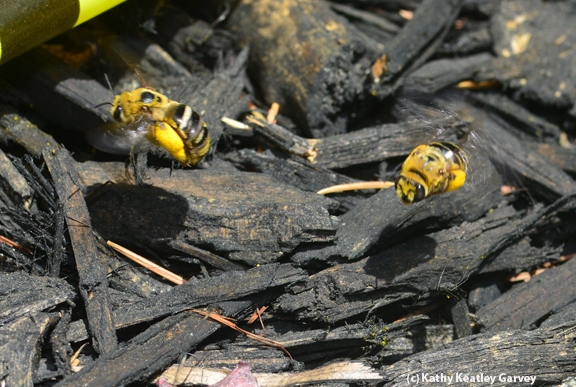
Sunflower bees, Svastra obliqua expurgata, flying to a nesting area in downtown Davis, Calif. (Photo by Kathy Keatley Garvey)
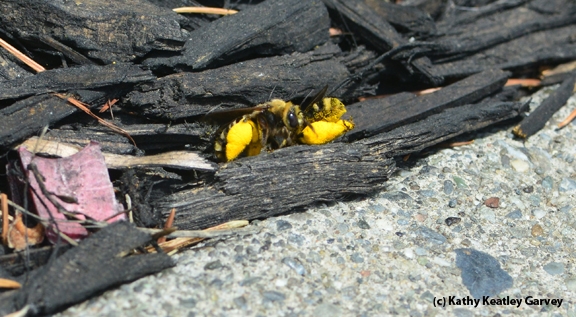
A sunflower bee delivering pollen to its nest. (Photo by Kathy Keatley Garvey)
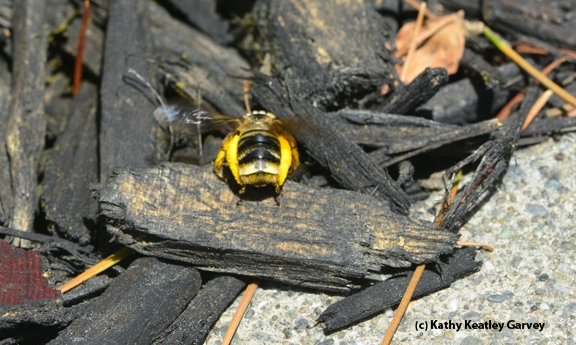
A pollen-packing sunflower bee making a deposit near a Davis bank. (Photo by Kathy Keatley Garvey)
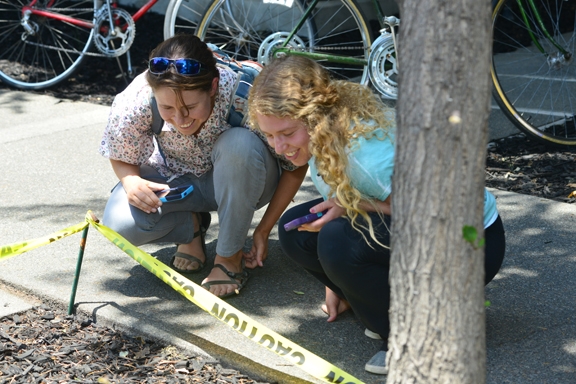
Lindsey Hack (left) and Allie Margulies of the Neal Williams lab, UC Davis, photographing the sunflower bees. (Photo by Kathy Keatley Garvey)
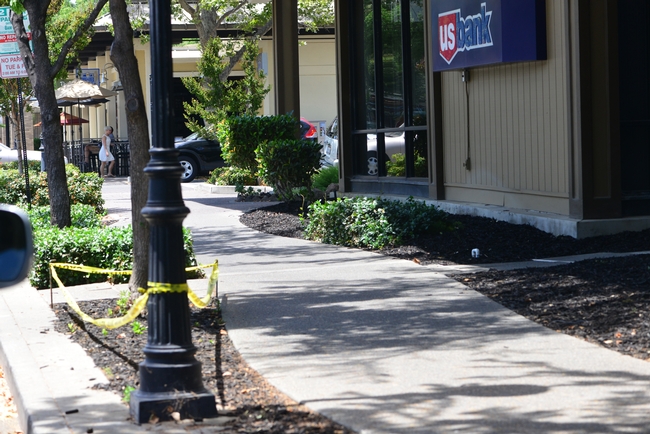
People make deposits in this bank, but sunflower bees are making deposits near the bank (left, in the wood chip mulch, circled here by yellow caution tape). (Photo by Kathy Keatley Garvey)